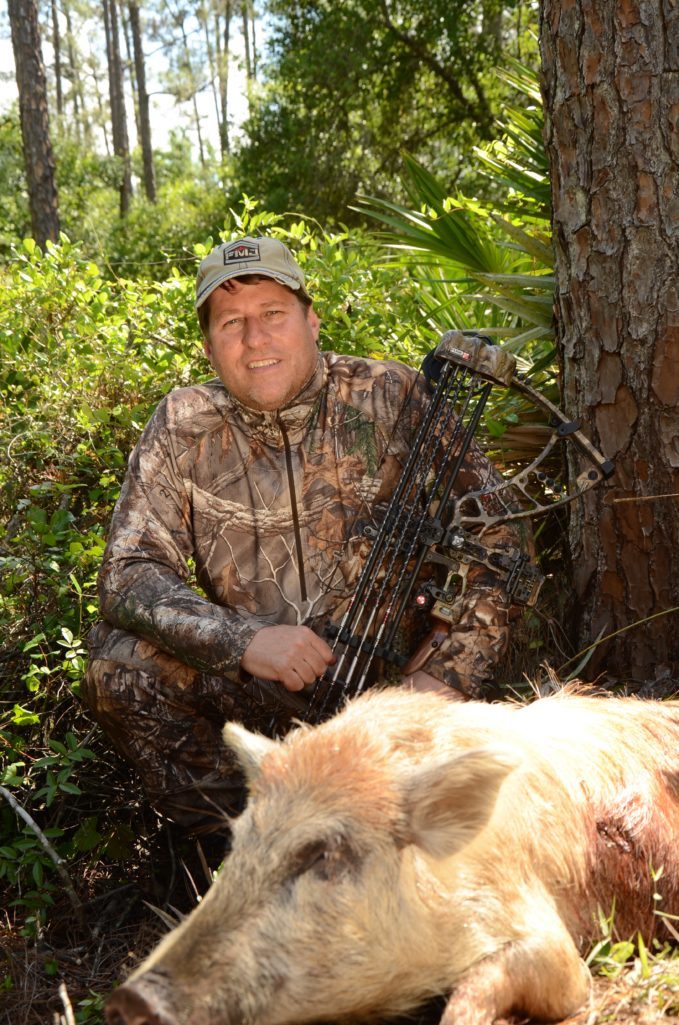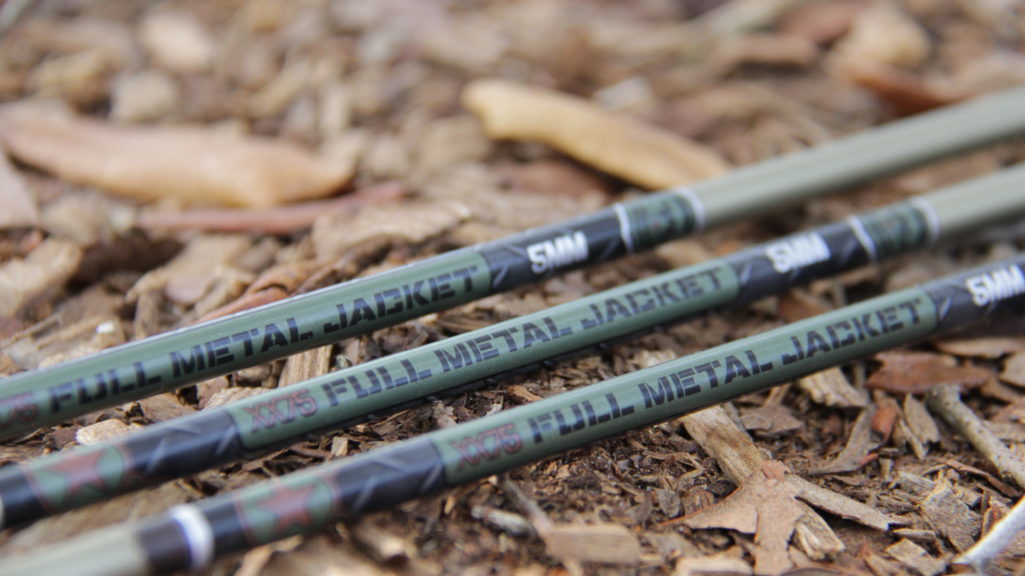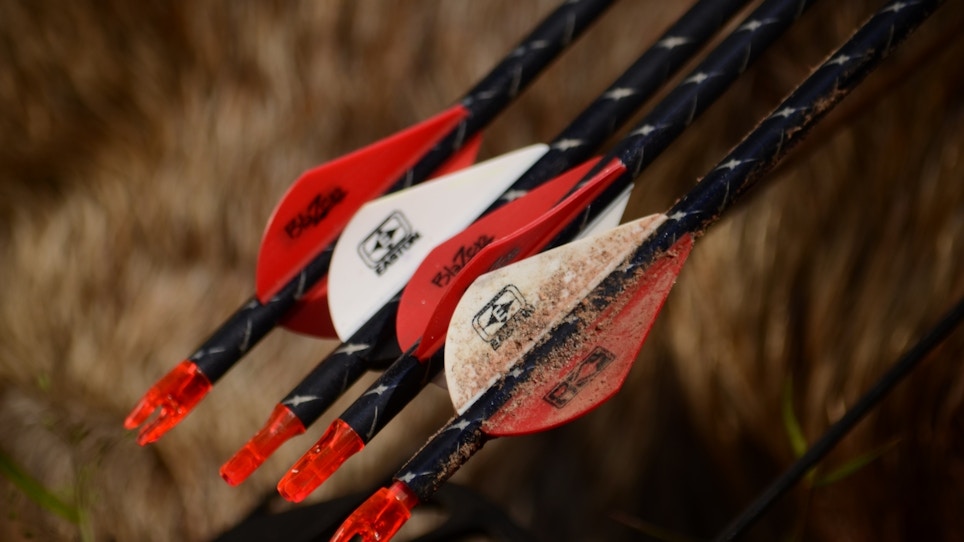I love arrows. Modern-day projectiles, for the most part, are small in diameter, fly with incomprehensible accuracy and penetrate deep. What more could we ask for? Plus, arrows are just plain sexy. Period. I love their sleek and stylish look, as well as the ability to further customize them with flashy wraps and vanes offered in a myriad of colors.
Recently, I had the opportunity to join Easton’s Marketing Manager Gary Cornum on a hog adventure in south Florida. The goal was simple: run some Easton arrows through a bunch of swamp swine and see how they performed. It was my kind of field test.
In the weeks leading up to the hunt, I sighted-in my Prime Centergy with Easton’s 5MM Full Metal Jacket. This is the meat and potatoes of the FMJ line — a micro-diameter killer boasting a high-strength carbon core wrapped in a 7075 metal jacket. Fitted with X Nocks and sporting Easton’s HIT (Hidden Insert Technology) inserts, these arrows resist wind drift and hit like a ton of bricks. One of my favorite features, especially when I’m shooting high-density foam targets, is the ease of arrow removal the metal jacket provides.
By simply swapping out sights, I also sighted-in with Easton’s XX75 Autumn Orange FMJ. The Autumn Orange look is a blast from the past, and though I wasn’t bowhunting when Autumn Orange was originally in style, staring at five of them in my quiver gave me a bit of nostalgia, taking me back to the days when my archery adventures consisted of reading bowhunting stories from the 70s and 80s. Like the 5MM, the 6MM features a carbon core and a 7075 alloy metal jacket. The main difference is, of course, the diameter, as well as the fact that the 6MMs feature standard 8-32 inserts. The larger diameter paired with the standard inserts allows Easton to sell these arrows at an economical price. Gary Cornum, in a phone conversation before the hunt, shed more light on this.
“Actually, the smaller in diameter we go, the more it costs us to make an arrow,” he explained. “It’s the process involved to make an arrow smaller in diameter that pushes the price. Being the 6MM have standard inserts and not HIT inserts, the price point goes down. The cool thing about the 6MM is guys and gals can now get into the FMJ line without shelling out as much money. They are still getting a quality micro-diameter arrow. At Easton, when it comes to shaft size, we don’t do anything standard. Plus, for many bowhunters, this classic look takes them back to their roots.”
Both arrows, as they’ve proved to be for me in the past, flew like darts, pulled easily from targets and produced a ton of kinetic energy. I was ready for some Florida hog action.
In the Field

Upon arrival at camp, I was treated to a dozen brand-new 5MM FMJ arrows. The only difference was these arrows were, much like the Autumn Orange 6MM, a throwback. Cloaked in the same camo as Easton’s once uber-popular XX75 Camo Hunter, the arrows proved pleasing to the eye. These arrows will be offered in a limited run by Easton.
I opted for my 5MM FMJ setup for my first night on stand. It is without question my favorite arrow in the FMJ line. I hadn’t been in the stand long when a pair of sows wandered in. I suppose I could’ve held out for the bigger boar that was on the bait when I was dropped off to come back, but that’s just not my style. I picked the bigger of the two sows — a coal-black 60-pounder — and settled my 20-yard pin. I’m not sure what happened, but the hit was too high, and I spined the sow. Yes, it dropped her in her tracks, but it wasn’t the shot I wanted to make. The good news: The 5MM FMJ, tipped with a prototype NAP head, cut the spine in half. I don’t mean punctured. I don’t mean cut. I mean cut cleanly in half. No, the arrow did not pass all the way through the sow, but 16 inches of my 28-inch shaft was sticking out the offside. Perhaps best of all, the arrow was in perfect shape when I removed it.
Later, back at camp, a few others toting the 5MM FMJ in the woods that evening shared their stories. Two had experienced complete pass-through shots. One made a clean miss. Gary shared his arrow expertise when it came to FMJ penetration.
“It’s the total package that makes it penetrate so well,” he said. “It’s the HIT technology and overall weight of the arrow. Plus, because the arrow is micro-diameter, the shaft can track directly behind the cutting path of the broadhead. And the slick nature of the aluminum reduces friction. When you have, say, a 420-grain arrow coming out of a modern-day 29-inch draw, 70-pound bow, you’re getting so much kinetic energy.”

My next evening on stand had me toting a different weapon, one I’d never taken to the woods before. It was the TenPoint Crossbow Carbon Phantom RCX. I’d spent the morning familiarizing myself with the horizontal rig and sending numerous Easton Full Metal Jacket Crossbow bolts downrange. These particular bolts were fitted with flat-back nocks and measured 22 inches in length. Showcasing a straightness rating of +/- .003, these bolts flew with deadly accuracy, and, oh, were they fast. My target of choice was an old 3-D boar target. You know the kind — the one that seems to melt to just about any arrow or bolt that slams into it. Even though my FMJ Crossbow bolts were buried in the target up to the fletch, I was able to remove them using only one hand. This was a much-appreciated feature.
Later that evening I found myself in a towering Florida pine, my heart racing, my head on swivel. Sure, I’ve arrowed lots of hogs over the years, but I was toting a new weapon, a new projectile and a new broadhead. It was that newness that added an extra element of excitement. I badly wanted to see what this trio of bow, broadhead and bolt would do. Hours later, in the fading Florida light, I got my opportunity. A pair of 100-pound boar hogs emerged from the dense brush. At 20 yards the unsuspecting duo was so focused on eating they failed to detect danger. The bolt was gone with the squeeze of the trigger, and because of the crossbow’s lack of recoil, I was able to see (through the scope) the white fletchings disappear in the boar’s hide. He didn’t make it 60 yards before piling up.
Later, when I climbed down to retrieve the bolt, approximately 9 inches of it was buried in the not-so-soft Florida soil. Simply amazing. Back at the lodge I learned my good friend and fellow outdoor writer Brad Fenson had also anchored a nice boar hog with a complete pass-through. His setup mirrored mine.
Over the course of three days a number of hogs fell victim to the FMJ line, a line that includes the 4MM, 5MM, 6MM and FMJ Crossbow. Cornum, as we were wrapping up the hunt, provided some additional insight into the line.
“There is an FMJ for everyone,” he said. “That’s what we want. If a guy or gal wants an arrow, we want them to know it’s in our FMJ line. We want them to walk into a pro shop and find the exact arrow or bolt they want to purchase. Those looking for an economical option should look no further than the 6MM. It’s a great way to get into the line and experience the performance of FMJ shafts. Our 5MM is our most popular model, and it really hits that sweet spot for most bowhunters. It’s loaded with purposeful technology and can be used to take down big game across the continent. Those looking to maximize penetration and accuracy — those who want the top of the heap — will want our 4MM. This arrow is ultra-micro-diameter and is Deep Six compatible. Deep Six is offered in our 4MM and 5MM line and really promises low friction and high kinetic energy.”
Archers go through arrows. It’s just a fact. Be sure your shop is a home to the entire FMJ line and be ready to meet your customers’ projectile needs. For more information, please visit www.eastonhunting.com.






